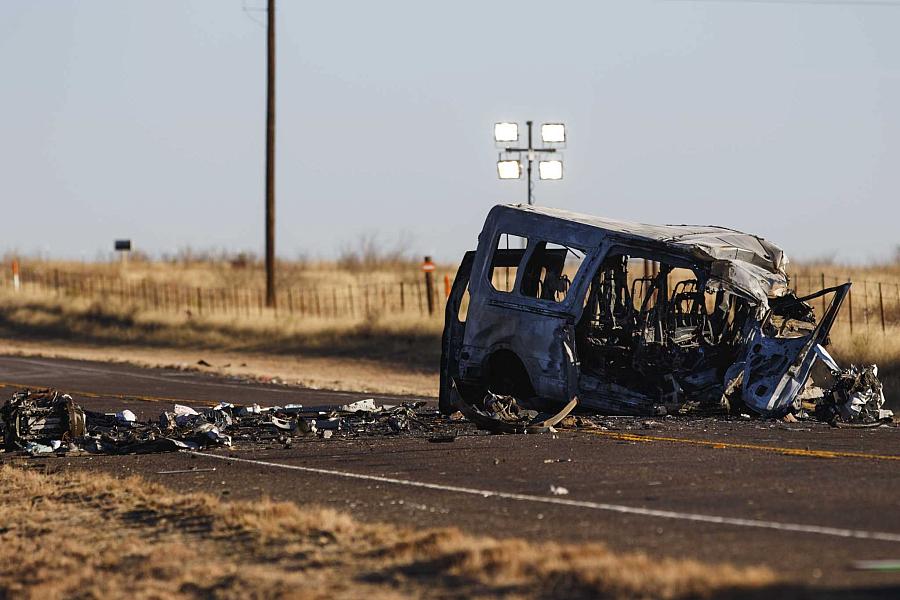Death from injury: America’s forsaken health crisis

The twisted remains of a van that had been transporting members of the University of the Southwest’s golf teams through West Texas in March 2022. Nine people were killed when the van collided with a pickup truck that crossed the center line into oncoming traffic.
(Photo by Eli Hartman/Odessa American)
Every day in the United States, hundreds of people die and thousands more suffer from an ongoing, deadly epidemic.
No, we are not talking about COVID-19.
It’s an even more intractable health crisis, an endemic problem that routinely harms Americans — sudden, acute injury.
Car crashes, pedestrian and bicyclist collisions, assaults, stabbings, shootings, falls, machinery accidents, natural and man-made disasters: no matter the cause or intention, the collective impact of these injurious incidents is breathtaking. Each year, nearly a quarter-million Americans die after suffering an abrupt injury, many before they could receive appropriate medical care in time. Millions more survive but often face persistent and debilitating health consequences.
Over time, the loss of life has been enormous, with more than 4.2 million Americans succumbing to injuries from 1999 through 2020, according to data from the Centers for Disease Control and Prevention. And while injury touches all ages and backgrounds, it disproportionately impacts the young, killing more children and people through middle age than any other cause. During the past two decades, it erased more than 84 million years of potential life in the United States, according to federal data.
Despite the undeniable human toll that injury inflicts on the American populace, there is a distinct lack of urgency in public and political awareness, as well as in the prevention and treatment of the problem.
In the United States, risking life and limb has somehow become an accepted price of the American way of life. Traumatic injury is all around us, an unabated stream of pain spotlighted on the nightly news and embedded in our social media feeds.
How many times have we driven past a car crash on the highway, gawking at the twisted metal remains of what once resembled a car before putting it out of our minds and continuing on with our days? How often do we hear the wail of sirens as ambulances and firetrucks rush to help someone in need?
Do any of these small tragedies — life changing for the victims and their families, but often perceived as unremarkable by the broader public — even register for the average American? It seems to take a significant loss of life, whether from a multi-vehicle pileup, a mass shooting or a building collapse, to break through the noise and make us ask why we allow these deaths to continue.
It is easy to dismiss many of these incidents as random and inevitable — so-called “acts of God.” But the causes of these injuries can be prevented. And, even in the many cases where they are not, the injuries can be treated to improve patient outcomes and, ultimately, save more lives.
For decades, leading experts in the fields of trauma and emergency medicine have proposed a host of policy changes that would curb injury deaths. They include increased funding for research, advancements in training and resources for EMS agencies, coordination with military doctors, adoption of military practices for treating critical wounds and the development of an overarching, national strategy by the federal government.
According to a 2016 report compiled by some of the nation’s top trauma and health policy experts, American trauma care is characterized by both remarkable innovation and insufficient implementation across the country’s complex health care system.
“Even as the successes have saved many lives, the gaps have cost many lives,” the report’s authors wrote.
“On one hand, the nation has never seen better systems of care for those wounded on the battlefield or severely injured within the United States,” they added. “On the other hand, many trauma patients, depending on when or where they are injured, do not receive the benefit of those gains. Far too many needlessly die or sustain lifelong disabilities as a result.”
As a reporter who has extensively covered health, medicine and COVID-19, I have learned that the root causes of and solutions for public health menaces can be anything but simple.
Enacting meaningful reforms requires substantive scientific evidence compiled and vetted by academic, public or private institutions. Those findings are amplified and propelled by growing public awareness and sustained pressure for change. Eventually comes the political will to act, the crucial component that unlocks funding, planning and concerted coordination between government agencies.
No small feat, to be sure. But it has been done before, with great success.
From cancer to heart disease, HIV to measles, mental illness to genetic disorders, the U.S. has mobilized a vast array of resources to address a host of urgent public health problems. This progress has been achieved through a combination of federal dollars, nonprofit advocacy, academic research and advances in private biomedical science.
The same tools and strategies can be harnessed to reduce injury and death from trauma.
The goal of this project, reported under the auspices of the 2022 National Fellowship, is to highlight the human toll of injury, its impact on individuals and their communities, and how it can be addressed.
My reporting for the Dallas Morning News will tease out the vast and complicated nature of trauma and emergency medical care in the U.S., including incremental successes, systemic failures and recent efforts to modernize these systems on a large scale. Using CDC data, we will analyze the incidence of trauma deaths and their burden on EMS and hospital systems. We will review hundreds of studies and interview dozens of medical experts as we explore evidence-based solutions that can help save lives.
And we will ask those in positions of power why a problem of such great magnitude has persisted for decades, without sufficient federal action.
We think it’s time for that to change.

